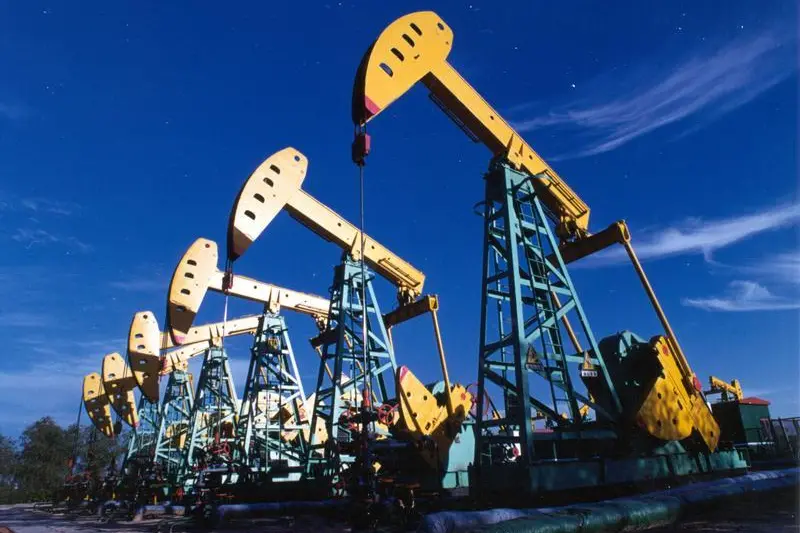PHOTO
Following fears of slowing oil demand and a global crude glut, a change of heart in the market brought hopes of oil rising at least to $50 a barrel by the end of the year. But the optimism is already starting to dwindle in the face of market realities, especially the possibility of a price rally-induced shale comeback.
In recent months a number of optimistic forecasts could be heard from the experts in the oil industry.
The International Energy Agency (IEA) said it can see a "light at the end of the tunnel as prices might have bottomed out". The Goldman Sachs Group in March mentioned that it is "spotting green shoots" and said the company expects oil to trade at $25-45 per barrel in the second quarter of this year, while it trimmed its 2017 WTI crude price forecast to $57 a barrel from $60.
RBC Capital Market's head of global commodities strategies, Helima Croft, told CNBC that the market's psychology has changed. "Everyone is now thinking about the recovery to $50," she said, adding that OPEC's freeze talk has influenced market sentiment. Societe Generale as well was convinced that fundamentals support $40 oil, and that by year-end the market will see $50 oil.
Sanford C. Bernstein & Co. went even further, saying the argument that $50 represents a ceiling for crude is flawed and forecasting prices returning to $70 in the next year. The industry can't stay profitable at current price levels, having lost $3 for each barrel produced last year even as companies squeezed costs, it said. "The price of oil has to rise to balance the market in the medium run, and the medium run might be sooner than people think," the firm's Senior Research Analyst Bob Brackett said in a report.
It's true that international benchmark Brent crude hit $43,47 at the time of writing, a 61% rally off the February 11 low of $27 a barrel, but the question is: what was its foundation, and above all, will it last? And while the oil price remains well above the lows it had hit early in February, analysts warn that prices will remain in this range and even be vulnerable to another sudden downward shift.
"We don't believe that any OPEC and non-OPEC freeze that may be agreed (which we assume will exclude Iran) will affect market psychology; it will be meaningless in terms of real crude supply." - Mike Wittner, Global Head of Oil Research, Societe Generale
Why the optimism?
In the oil market, nothing has really changed. Demand is still slowing, there's still a supply glut, there were no major shake-ups among producers and no agreements were signed yet. So where did all this optimism stem from? Saudi Arabia and Russia are pledging only to limit their output to some ten million barrels a day, an amount near record highs, which is unlikely to rebalance an oversupplied market. Iran, on the other hand, has made clear it will increase production and the market's already seen shipments from Iran to Europe. Reuters estimates that supply has risen from one million to more than three million barrels a day, and the BBC reported the country's oil minister saying it will not discuss any deals until it has matched its pre-sanctions level of four million.
In Helima Croft's view, Iran is set for 5% growth rates this year because of sanctions coming off. "Iran seemed to deep-six any idea that it would sign on for an OPEC-Russia plan to freeze output as its energy minister again stated that the country would only consider a cap on production once it reached 4 mb/d", she told Qatar Today in a statement. "It remains to be seen whether this is the final word or an attempt to exact better terms. Iran may not feel the same economic urgency as other OPEC members, as it is the only one facing a brighter outlook on a year-on-year basis even in the current price environment, as it is set to benefit from the lifting of sanctions." Nonetheless, she points out, it is also worth remembering that the Supreme Leader publicly announced a set of inflexible red lines in the late stages of the nuclear negotiations, only to backtrack later.
Meanwhile, OPEC predicted that demand would be lower this year than expected and would average 31.52 million barrels per day in 2016, while the organisation's last forecast said production was holding at levels that exceed the amount of oil it is selling. As Societe Generale's Global Head of Oil Research, Mike Wittner told Qatar Today, "We don't believe that any OPEC and non-OPEC freeze that may be agreed (which we assume will exclude Iran) will affect market psychology and will be meaningless in terms of real crude supply."
Moreover, the IEA reported last week that US crude inventories for the week of Febraury 26 increased by 6.6 million barrels from the previous week. The agency added that "At 536.5 million barrels, US crude oil inventories are at historically high levels for this time of the year." With US stockpiles being at all-time highs and the Organisation for Economic Co-operation and Development's OECD's prediction that global reserves will rise from last year's three billion barrels to 3.24 billion in 2016 and then on to 3.3 billion barrels by the end of 2017, there is only one conclusion to draw. The price rally optimism was obviously just that. Optimism - a sentiment, hardly based on facts.
Crude price outlook revised down
Accordingly, the latest expert reports have grown more cautious in their forecasts. Wittner commented on revised prices of crude for 2016 (see box). Croft adds that while markets remain constructive this year, the path higher will not be without headwinds. "Recent producer activity has suggested that term prices above the $45/bbl level will likely bring more hedgers out of the woodwork. The rebound in prices will be slow given that the memory of last spring's short covering rally proved premature and contributed to the resiliency of US production."
However, there are still those that see oil climbing noticeably by the end of the year. As Luana Siegfried, Research Associate at Raymond James Financial in Houston, Texas told us. "While prices keep trading at $35-40 levels, we expect operators to cut production. In terms of recovery, it can be as soon as oil stabilises at higher levels with a high degree of certainty. We assume oil prices rebounding to $60 in the second half of this year."
A self-defeating rally
Even if the price of crude did climb higher, that wouldn't necessarily mean recovery is underway. A price rally could have quite the opposite effect. "In 2016, any sustained rally above $45 should be self-limiting," Wittner is convinced, "because if that happens, US shale producers would increase spending, drilling, and - after a time lag - production. This is an important element of the relatively flat and range-bound near-term price forecast."
Falling US production is the key to get supply to equal demand, and that seems an increasingly difficult goal to achieve. While US crude production has retreated 5.5% since last summer, US production is proving stubbornly resilient, and US output is still running at more than nine million barrels a day even as drillers are using the fewest rigs since 2009. As a result of higher production efficiency the price range that allows output to be profitable has fallen by $10 since last year to $45-55 a barrel. Moreover, this year's rally has already helped US drillers raise $10 billion of extra funds on Wall Street.
Goldman Sachs thus warns that prices still need to stay low enough to wash out more US production.
The current movement in prices has further potential to bring back shale oil output, "reversing nascent supply curtailments" and preventing the market from properly rebalancing
© Qatar Today 2016












